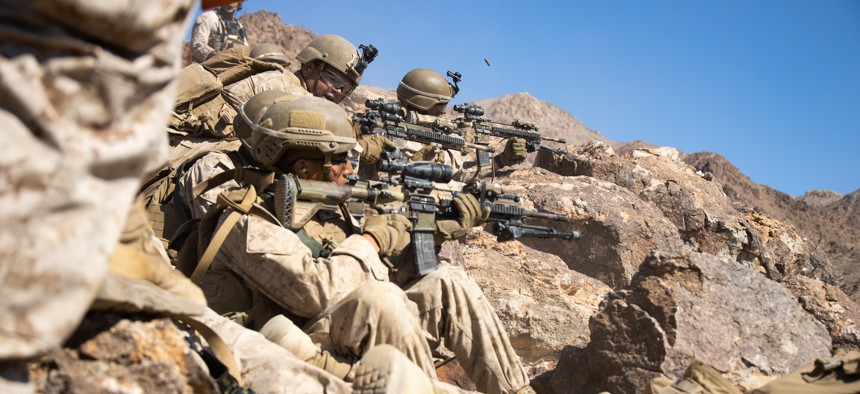
U.S. Marines with Kilo Company, 3d Battalion, 1st Marine Regiment, 1st Marine Division, provide security while conducting Range 400 as a part of Integrated Training Exercise (ITX) 3-22 at Marine Corps Air Ground Combat Center Twentynine Palms, California, April 8, 2022. U.S. Marine Corps / Lance Cpl. Brayden Daniel
Marines Are Learning from the Ukraine Conflict—But Are Wary of Adjusting Force Design Based on It
Education, training, concepts, and equipment purchases are changing, but not Force Design 2030.
The Marine Corps is incorporating lessons from Ukraine’s defense into its training and acquisition decisions. And while they are not reflected in the just-released update to Force Design 2030, they may influence future versions.
“I've learned to be disciplined a little bit in what we learn while you're in the middle of it, sort of thing. Because it can look one way, but then a year later, ‘Woo, okay, I couldn’t see the whole forest there,” Marine Commandant Gen. David Berger told reporters recently.
Berger cited Ukraine’s sinking of the Moskva, the flagship of Russia’s Black Sea fleet, with an anti-ship missile. He said one incident alone does not validate or invalidate Force Design 2030—the commandant’s plan to overhaul the Corps for the next decade—but it is an example of what they are working on and the vulnerabilities of ships from missiles.
“That said, the ability of Ukraine to complete the kill chain of locate, target, track target, fuse that data to a weapon system and engage, and then assess, it worked with a ground-based, anti-ship missile. This is the direction the Marine Corps is going as part of what the nation needs us to do in sea control and sea denial,” he said.
More immediately, Berger said, the Marine Corps are funneling lessons from Ukraine into education and training, and concepts, and equipment purchases. For example, Marines today learn to maneuver with machine-gun fire towards an objective and kill the enemy. In the future, he said, he wants platoons to also know how to use Switchblade drones and other sensors, as Ukrainian forces do, to kill the enemy from a distance.
More broadly, he said the war so far has proved the “value” of small units, ground forces, and information—echoing the Marines’ Force Design efforts, which call for light, agile stand-in forces that can operate close to and deter an adversary.
The small units with sensing and lethal capabilities are able to “overmatch” larger units that have huge logistical demands, Berger said.
“They're easy to detect…just are giant, slow-moving targets. Smaller; more distributed; sensing; ability to kill. Boy, that's-—the Ukrainians are, in spades, showing that,” he said.
Berger said the fight in Ukraine is disproving a notion advanced over the last few decades: that newer technology would allow militaries to “to stand off and lob these weapons at each other and hold each other at bay over great distances. And the precision and all that would make like the close-in-battle sort of a thing of the past. Not so much. Not at all.”
Don't miss:
The commandant is also watching how Ukrainian civilians and military forces are using information: earlier and in a faster cycle against Russian forces, who cannot seem to catch up or get ahead of it.
“And the Ukrainians are like one-half a step, every day, in front of the information space. Using the information space in really powerful ways,” he said.
Berger said the U.S. and its allies should carefully consider how they share intelligence.
“We have shared information intelligence at a much faster pace, and more broadly than I've seen us do in the past,” he said. “If allies and partners are not just nice-to-have, but critical, how then do we share intelligence that we have more openly, more broadly, faster, than perhaps we have historically?”




